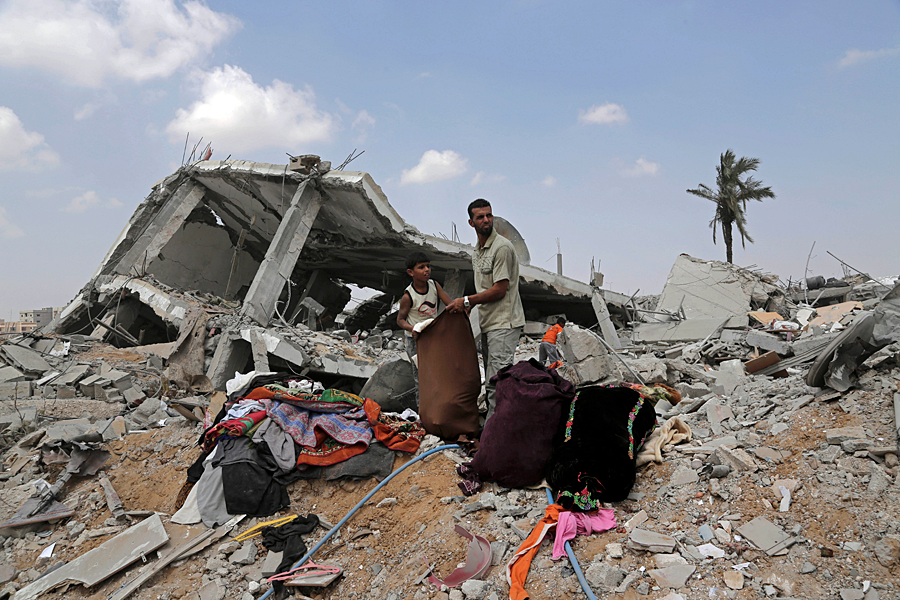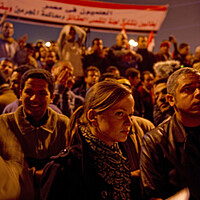In this Gaza neighborhood, a possible Israeli war crime
| Khan Younis, Gaza Strip
It had been three nightmare nights. Faten Qdeih and her six children had fled Israeli shelling of their home, but were trapped by tanks and soldiers that shot at the crowd trying to escape. Wherever they went, explosions followed.
And it wasn't over.
A mortar shell rocked the building where they had taken refuge on the third day. Ms. Qdeih, bleeding from shrapnel, rushed the family into the street. Dodging shells, they ran to another building. It was hit too. Her seven-year-old son Anas dashed outside in fear just as another strike landed. Qdeih followed him and found his lifeless body.
Her daughters screamed. Dizzy, Qdeih made a heart-wrenching decision: She left her dead son behind and ran with the living. “I would rather I had died than see what I've seen," she said later.
Qdeih is one of the survivors of the Israeli assault in late July on Khuzaa, a neighborhood on the eastern edge of Khan Younis in southern Gaza, within sight of the Israeli border.
What unfolded in Khuzaa between July 21 and 25 amounts to a war crime, according to a dozen witnesses interviewed by the Monitor and an independent investigation by Human Rights Watch. HRW calls what happened there – the shelling, a refusal to allow civilians safe passage – an "apparent violation of the laws of war."
"When will there be justice for the civilians in Khuzaa, who suffered shelling for days, then faced deadly attacks by Israeli soldiers after being ordered to leave the town?" asked the group's Middle East director, Sarah Leah Whitson, in a statement released Monday.
The survivors are asking the same question as the latest Israel-Gaza war appears to be dying down. In the days ahead, the debate over whether the level of force used by Israel in Gaza was legitimate or illegal is likely to remain heated.
While the events in Khuzaa are just a snapshot from a short, sharp war, similar tales are told from other Gaza neighborhoods, particularly ones close to the border with Israel. Israel is likely to have to answer in the coming weeks and months why so many more civilians were killed in the latest conflict with Hamas in Gaza than in previous engagements.
Thwarted flight
Khuzaa survivors say efforts to flee were blocked by Israeli tanks and that Israeli soldiers shot at them as they waved white flags. Emergency responders say the Israel Defense Forces (IDF) shot at ambulances trying to enter the area.
The IDF says it makes an extraordinary effort to avoid civilian casualties and gives civilians a chance to evacuate. Civilian casualties, the IDF says, are inevitable because Hamas fighters mingle among civilians using them as "human shields." The IDF did not respond to seven requests for comment over five days about its version of events in the neighborhood.
It's not just Khuzaa. On Sunday an Israeli attack at a United Nations-run shelter in the southern town of Rafah left 10 people dead, prompting outrage from the UN and the US. State Department Spokeswoman Jen Psaki said in a statement the US "is appalled by today’s disgraceful shelling."
It was the sixth such shelter hit in the nearly month-old conflict. Hospitals and Gaza's lone power station have been hit too, as have hundreds of homes and apartment blocks. Israel says all were legitimate military targets.
For the former residents of Khuzaa, Israeli culpability is assumed. And the events that drove them from their homes are likely to be scrutinized and argued about for years to come.
The recent past
Violence in Khuzaa isn't new. During Israel's "Operation Cast Lead" offensive in 2008-2009, Israeli soldiers fired on a group of women and children attempting to leave Khuzaa, according to a UN factfinding commission. One woman died as soldiers prevented ambulance access.
The losses could be worse this time. Ashraf Al Qedra, spokesman for Gaza's Health Ministry, estimated that more than 100 people died in the incident.
The assault on Khuzaa began July 21. Ahead of the attack, Israel dropped leaflets warning people to evacuate, but Qdeih says she never saw them. House-shaking, glass-shattering explosions soon followed. She huddled at home with her four daughters and two sons, unsure of what to do.
On Wednesday morning, July 23, Qdeih and hundreds of neighbors decided to flee. They gathered together, raised white flags, and walked toward what they hoped was safety. They quickly encountered Israeli tanks.
The soldiers in the tanks opened fire, according to witnesses. “The first bullet struck someone pushing the wheelchair for his handicapped sister,” says Esma Abu Erjala. “When they started shooting, we were falling over one another” trying to escape.
The girl in the wheelchair was left behind.
Many took shelter in the home of a doctor, Kamal Qdeih. He treated those who had been shot – around two dozen – as airstrikes continued. Ms. Erjala's sister was shot in the abdomen. She called for ambulances, but none came.
The women and children gathered in a building next to the doctor's home, where they huddled on the floor. They made sure there were no fighters in their midst, says Qdeih. In the morning she gave her son Anas a date, which he shared with his brother, and a spoiled cucumber, the only food available. After this small meal, a mortar hit the house. Qdeih was hit with shrapnel.
She ran out of the house with her children, and into the mortar bombardment that killed her son.
Another escape attempt
About 70 others in Khuzaa spent the night in a basement, and when they emerged in the morning on July 24, says Erjala, they "found a wasteland."
Mohamed Ismail says people were willing to risk the tanks. “We decided it's better to go there than to wait for death."
A group gathered, and men took off their shirts and shoes to avoid being mistaken for militants. They once again raised white cloths. Kamal Qdeih says the men yelled “peaceful!” as they walked. “We were not expecting to get out alive,” says Erjala. They left behind the seriously wounded.
Erjala and her nephew were burdened with their wounded relative. Wael Abu Erjala says he'll be haunted by a boy, dying in the street and calling for help. “I was carrying my aunt so I couldn't go to him. … I don't think I'll ever sleep after what I saw.”
On this try, they encountered Israeli soldiers who directed them to leave, ending what Wael Abu Erjala calls “three days of hell.”
Ambulances?
Ziad Abu Amr tried to evacuate people from Khuzaa on the morning of July 24. He called people in the district, urging them to move forward, but withdrew after watching a missile from a drone hit a motorized tricycle trying to bring people out.
Wesam Nebhan of Khan Younis's European Hospital says he accompanied an ambulance on four attempts to rescue Khuzaa residents the morning of July 24, but they were repelled. “This is really a massacre,” he says.
A spokeswoman for the International Committee of the Red Cross says the organization arranged passage for ambulances into Khuzaa three times, evacuating 18 unharmed civilians as well as 10 wounded and seven dead. But the ambulances that entered had limited access. Many of the dead and wounded were left behind.
On July 25, Israeli forces fired on an ambulance entering Khuzaa, killing a paramedic, according to the ICRC. Dr. Qedra, of the health ministry said that five paramedics were killed trying to reach the wounded.
Sameh Al Burai and Ahmed Aldabba contributed to this report.






